Note
Go to the end to download the full example code. or to run this example in your browser via Binder
Transmit Field Simulation#
Example of transmit field (i.e., B1+) map generation.
This examples show how to generate coil sensitivity maps for a single or multi-channel transmit array.
import matplotlib.pyplot as plt
import numpy as np
from mrtwin import b1field
plt.rcParams["image.cmap"] = "hot"
Basic Usage#
Two- and three-dimensional transmit field maps
can be generated providing (ny, nx) and
(nz, ny, nx) shaped tuple as a shape argument
to b1field routine, respectively:
b1map2D = b1field(shape=(200, 200)) # (200, 200) matrix
print(b1map2D.shape)
b1map3D = b1field(shape=(128, 128, 128)) # (128, 128, 128) matrix
print(b1map3D.shape)
plt.figure()
plt.imshow(b1map2D), plt.axis("off"), plt.colorbar(), plt.title(
"transmit field (in units of relative flip angle)"
)
plt.show()
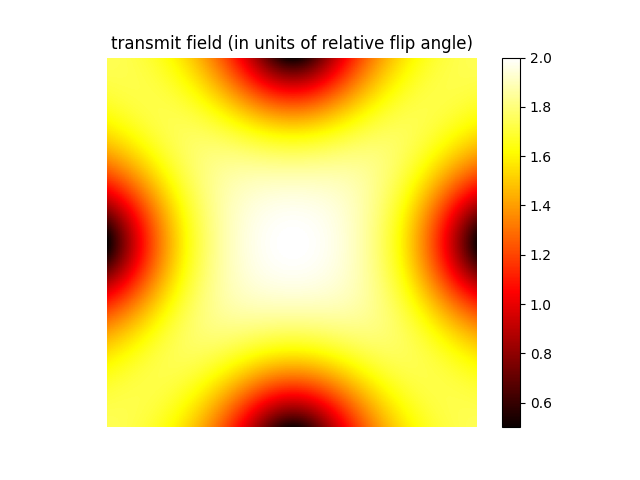
(200, 200)
(128, 128, 128)
The transmit field maps are generated with a relative flip angle variation between 0.8 and 1.2 (e.g., 3T systems).
This can be changed via the b1range argument:
b1map2D = b1field(shape=(200, 200), b1range=(0.5, 2.0))
plt.figure()
plt.imshow(b1map2D), plt.axis("off"), plt.colorbar(), plt.title(
"transmit field with b1range between 0.5 and 2.0"
)
plt.show()

This can be used e.g., to simulate field maps for higher fields (e.g., 7T systems).
Optionally, we can provide a mask of the object to exclude the background when calculating the field rescaling:
from mrtwin import shepplogan_phantom
mask = shepplogan_phantom(ndim=2, shape=(200, 200), segtype=False).M0 != 0.0
b1map2D = b1field(shape=(200, 200), mask=mask)
plt.figure()
plt.imshow(b1map2D), plt.axis("off"), plt.colorbar(), plt.title("masked transmit field")
plt.show()
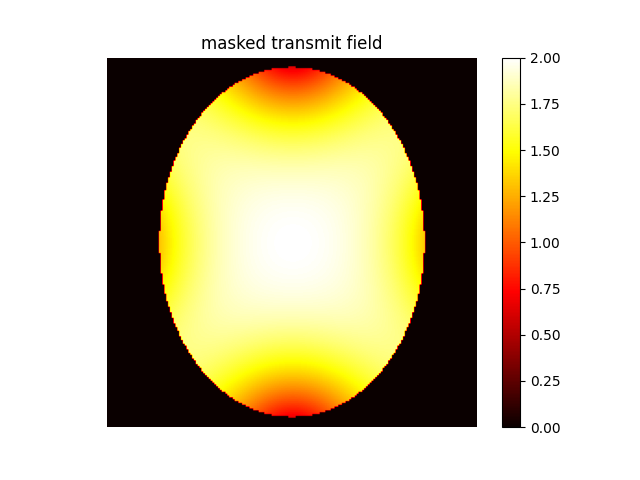
Advanced Options#
The sensitivity maps can be altered by modifying several parameters:
coil_width: width of the coil (with respect to FOV).shift: displacement of the center (in units of voxels).dphi: bulk rotation of the coil (in [deg]).ncoils: number of transmit channels in the transmit array.nrings: number of rings for a cylindrical hardware setup.
Without loss of generality, we show examples for 2D sensitivities:
Coil width#
widths = [0.5, 1.0, 1.5, 2.0]
b1map2D = [
b1field(shape=(200, 200), coil_width=w) for w in widths
] # only show first channel
display = np.concatenate(b1map2D, axis=1)
plt.figure()
plt.imshow(abs(display)), plt.axis("off"), plt.colorbar(), plt.title(
"coil width from 0.5 to 2.0 times fov"
)
plt.show()
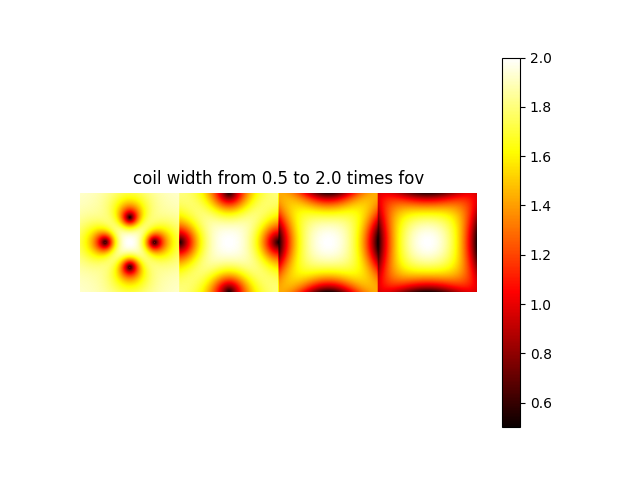
Center shift#
dx = [-20, -10, 0, 10, 20]
b1map2D = [
b1field(shape=(200, 200), shift=(0, x), coil_width=0.5) for x in dx
] # for 3D, it would be shift=(dz, dy, dx)
display = np.concatenate(b1map2D, axis=1)
plt.figure()
plt.imshow(abs(display)), plt.axis("off"), plt.colorbar(), plt.title(
"x-displacement from -20 to 20 times voxels"
)
plt.show()

Rotation#
phi = [-20, -10, 0, 10, 20]
b1map2D = [b1field(shape=(200, 200), dphi=angle, coil_width=0.5) for angle in phi]
display = np.concatenate(b1map2D, axis=1)
plt.figure()
plt.imshow(abs(display)), plt.axis("off"), plt.colorbar(), plt.title(
"coil rotation from -20 to 20 degrees (first channel)"
)
plt.show()
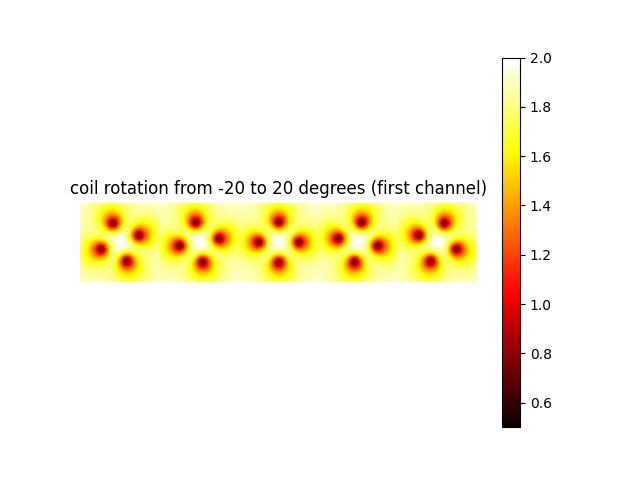
Number of rings#
ncoils = [1, 2, 4, 8, 16, 32]
b1map2D = [b1field(shape=(200, 200), ncoils=n, coil_width=0.5) for n in ncoils]
display = np.concatenate(b1map2D, axis=1)
plt.figure()
plt.imshow(abs(display)), plt.axis("off"), plt.colorbar(), plt.title(
"number of channels from 1 to 16"
)
plt.show()
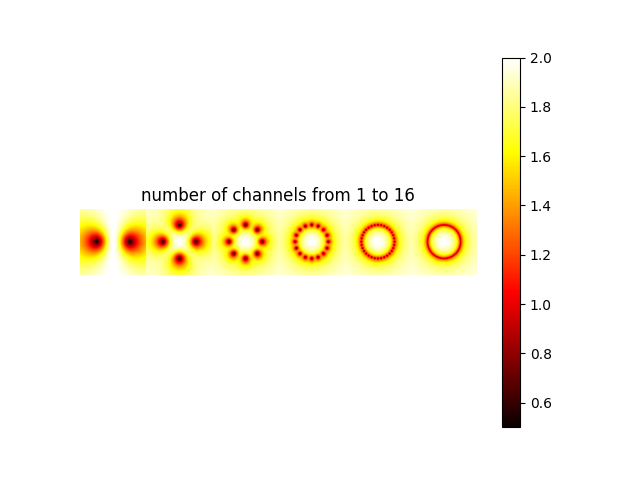
Number of rings#
nrings = [2, 4, 6, 8, 10]
b1map2D = [b1field(shape=(200, 200), nrings=n, coil_width=0.5) for n in nrings]
display = np.concatenate(b1map2D, axis=1)
plt.figure()
plt.imshow(abs(display)), plt.axis("off"), plt.colorbar(), plt.title(
"number of rings from 2 to 10 (first channel)"
)
plt.show()
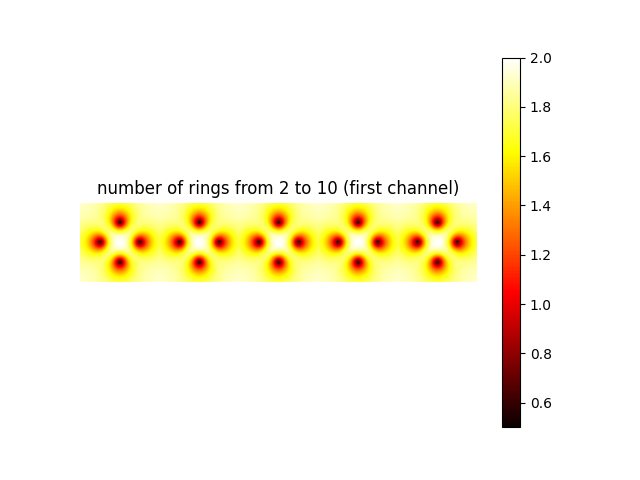
Multiple Transmit Modes#
By default, the sensitivities from each transmit channel are combined in quadrature mode.
With mrtwin, multiple orthogonal modes can be simulated by nmodes argument.
For example, CP mode and gradient modes (e.g., for static pTx) can be obtained as:
In this case, b1map will be a (nmodes, *shape) np.ndarray, the different
modes being stacked along the first axis:
fig, ax = plt.subplots(2, 2)
im0 = ax[0, 0].imshow(np.abs(b1map[0]))
ax[0, 0].axis("off"), ax[0, 0].set_title("CP mode (magn)")
fig.colorbar(im0, ax=ax[0, 0], fraction=0.046, pad=0.04)
im1 = ax[0, 1].imshow(np.angle(b1map[0]))
ax[0, 1].axis("off"), ax[0, 1].set_title("CP mode (phase)")
fig.colorbar(im1, ax=ax[0, 1], fraction=0.046, pad=0.04)
im2 = ax[1, 0].imshow(np.abs(b1map[1]))
ax[1, 0].axis("off"), ax[1, 0].set_title("gradient mode (magn)")
fig.colorbar(im2, ax=ax[1, 0], fraction=0.046, pad=0.04)
im3 = ax[1, 1].imshow(np.angle(b1map[1]))
ax[1, 1].axis("off"), ax[1, 1].set_title("gradient mode (phase)")
fig.colorbar(im3, ax=ax[1, 1], fraction=0.046, pad=0.04)
plt.show()
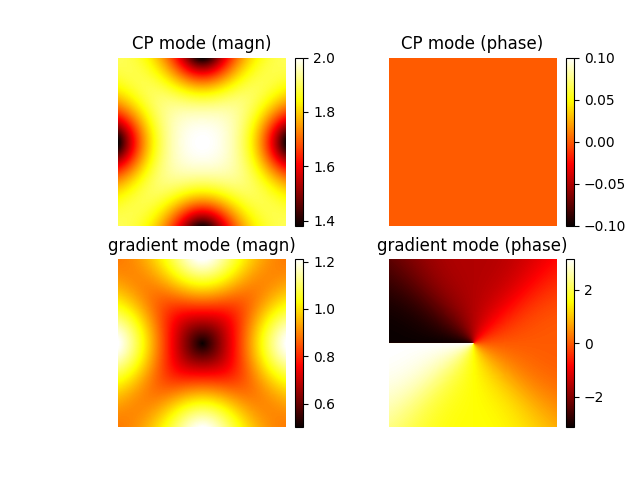
Caching mechanism#
To reduce loading times, mrtwin implements a caching mechanism.
If cache argument is set to True (default behaviour for ndim=3), each transmit field map
segmentation (identified by the number of channels, number of modes,
matrix size, shift, rotation angle, number of rings, b1 range and masking flag)
is saved on the disk in npy format.
The path is selected according to the following hierachy (inspired by brainweb-dl):
User-specific argument (
cache_dir)MRTWIN_DIRenvironment variable~/.cache/mrtwinfolder
Total running time of the script: (0 minutes 1.359 seconds)